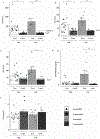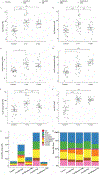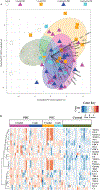Fenofibrate Improves Liver Function and Reduces the Toxicity of the Bile Acid Pool in Patients With Primary Biliary Cholangitis and Primary Sclerosing Cholangitis Who Are Partial Responders to Ursodiol
- PMID: 32480421
- PMCID: PMC7886378
- DOI: 10.1002/cpt.1930
Fenofibrate Improves Liver Function and Reduces the Toxicity of the Bile Acid Pool in Patients With Primary Biliary Cholangitis and Primary Sclerosing Cholangitis Who Are Partial Responders to Ursodiol
Abstract
Cholestatic liver diseases result in the hepatic retention of bile acids, causing subsequent liver toxicity. Peroxisome proliferator-activated receptor alpha (PPARα) regulates bile acid metabolism. In this retrospective observational study, we assessed the effects of fenofibrate (a PPARα agonist) therapy on bile acid metabolism when given to patients with primary biliary cholangitis (PBC) and primary sclerosing cholangitis (PSC) who have had an incomplete response to Ursodiol monotherapy. When fenofibrate was added to Ursodiol therapy there was a significant reduction and in some cases normalization of serum alkaline phosphatase, alanine aminotransferase, and aspartate aminotransferase abnormalities, as well as pro-inflammatory cytokines. Combination fenofibrate treatment also reduced 7α-hydroxy-4-cholesten-3-one (C4), the bile acid precursor, as well as total, primary, and conjugated bile acids. In addition, principal components analysis and heatmap analysis show that bile acid metabolites trended closer to that of healthy control subjects. These favorable effects of fenofibrate on bile acid metabolism may contribute to its beneficial clinical effects in patients with PBC and PSC experiencing a subtherapeutic response to Ursodiol monotherapy.
© 2020 The Authors. Clinical Pharmacology & Therapeutics © 2020 American Society for Clinical Pharmacology and Therapeutics.
Conflict of interest statement
CONFLICT OF INTEREST
All authors declared no competing interests for this work.
Figures






Similar articles
-
Adjunct Fenofibrate Up-regulates Bile Acid Glucuronidation and Improves Treatment Response For Patients With Cholestasis.Hepatol Commun. 2021 Dec;5(12):2035-2051. doi: 10.1002/hep4.1787. Epub 2021 Aug 27. Hepatol Commun. 2021. PMID: 34558841 Free PMC article.
-
Effect of different doses of ursodeoxycholic acid in chronic liver disease.Dig Dis Sci. 1989 Dec;34(12 Suppl):59S-65S. doi: 10.1007/BF01536665. Dig Dis Sci. 1989. PMID: 2598769 Clinical Trial.
-
Fenofibrate in primary sclerosing cholangitis; a randomized, double-blind, placebo-controlled trial.Pharmacol Res Perspect. 2022 Aug;10(4):e00984. doi: 10.1002/prp2.984. Pharmacol Res Perspect. 2022. PMID: 35822553 Free PMC article. Clinical Trial.
-
[Novel Insights of Primary Sclerosing Cholangitis and Primary Biliary Cholangitis].Korean J Gastroenterol. 2020 May 25;75(5):246-256. doi: 10.4166/kjg.2020.75.5.246. Korean J Gastroenterol. 2020. PMID: 32448856 Review. Korean.
-
Novel and emerging therapies for cholestatic liver diseases.Liver Int. 2018 Sep;38(9):1520-1535. doi: 10.1111/liv.13880. Epub 2018 Jun 14. Liver Int. 2018. PMID: 29758112 Review.
Cited by
-
Fibrotic Events in the Progression of Cholestatic Liver Disease.Cells. 2021 May 5;10(5):1107. doi: 10.3390/cells10051107. Cells. 2021. PMID: 34062960 Free PMC article. Review.
-
Anti-inflammatory role of fenofibrate in treating diseases.Biomol Biomed. 2023 May 1;23(3):376-391. doi: 10.17305/bb.2022.8534. Biomol Biomed. 2023. PMID: 36724021 Free PMC article. Review.
-
Peroxisome Proliferator-Activated Receptors Regulate Hepatic Immunity and Assist in the Treatment of Primary Biliary Cholangitis.Front Immunol. 2022 Jul 8;13:940688. doi: 10.3389/fimmu.2022.940688. eCollection 2022. Front Immunol. 2022. PMID: 35880178 Free PMC article. Review.
-
Adjunct Fenofibrate Up-regulates Bile Acid Glucuronidation and Improves Treatment Response For Patients With Cholestasis.Hepatol Commun. 2021 Dec;5(12):2035-2051. doi: 10.1002/hep4.1787. Epub 2021 Aug 27. Hepatol Commun. 2021. PMID: 34558841 Free PMC article.
-
Metabolomic Analysis Reveals the Therapeutic Effects of MBT1805, a Novel Pan-Peroxisome Proliferator-Activated Receptor Agonist, on α-Naphthylisothiocyanate-Induced Cholestasis in Mice.Front Pharmacol. 2021 Oct 29;12:732478. doi: 10.3389/fphar.2021.732478. eCollection 2021. Front Pharmacol. 2021. PMID: 34776958 Free PMC article.
References
Publication types
MeSH terms
Substances
Grants and funding
LinkOut - more resources
Full Text Sources
Miscellaneous

